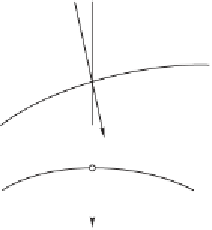Geoscience Reference
In-Depth Information
n'
n
geoid
W=
0
P
N
g
P
Q
reference
ellipsoid
U=
0
°
°
Q
Fig. 2.12. Geoid and reference ellipsoid
T
is called the
anomalous potential
,or
disturbing potential
.Wecomparethe
geoid
W
(
x, y, z
)=
W
0
(2-225)
with a reference ellipsoid
U
(
x, y, z
)=
W
0
(2-226)
of the same potential
U
0
=
W
0
.Apoint
P
of the geoid is projected onto
the point
Q
of the ellipsoid by means of the ellipsoidal normal (Fig. 2.12).
The distance
PQ
between geoid and ellipsoid is called the
geoidal height
,or
geoidal undulation
, and is denoted by
N
. Unfortunately, there is a conflict of
notation here. Denoting both the normal radius of curvature of the ellipsoid
and the geoidal height by
N
is well established in geodetic literature. We
continue this practice, as there is little chance of confusion.
Consider now the gravity vector
g
at
P
and the normal gravity vector
γ
at
Q
.The
gravity anomaly vector
∆
g
is defined as their difference:
∆
g
=
g
P
−
γ
Q
.
(2-227)
A vector is characterized by magnitude and direction. The difference in mag-
nitude is the
gravity anomaly
∆
g
=
g
P
−
γ
Q
;
(2-228)
the difference in direction is the
deflection of the vertical
.
The deflection of the vertical has two components, a north-south com-
ponent
ξ
and an east-west component
η
(Fig. 2.13). As the direction of the
vertical is directly defined by the astronomical coordinates latitude Φ and
longitude Λ, the components
ξ
and
η
can be expressed by them in a sim-
ple way. The actual astronomical coordinates of the geoidal point
P
,which




